Introduction
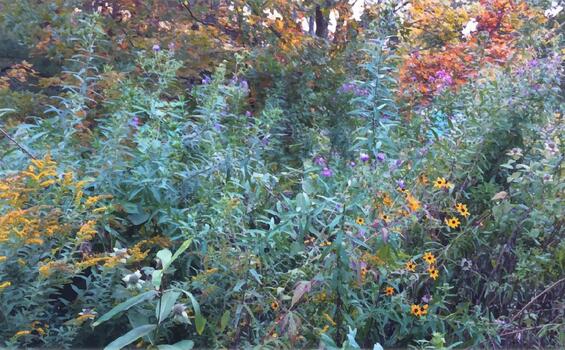
Native plants require far less care, watering, and chemical use than traditional lawns.
“Green” lawn and garden practices are environmentally friendly yard care methods, such as planting native species, conserving water, and reducing fertilizer and chemical use. Going green with your landscaping provides a range of environmental benefits and can save both time and money. This fact sheet focuses on proven landscaping strategies to reduce the quantity and contamination of stormwater runoff, organized into the following topic areas: Less Lawn, “Green” Lawn Techniques, Water Conservation, Reduced Chemical Use, Wildlife Habitat, and Rain Barrels. For a broader look at landscaping to reduce pollution, conserve water, support wildlife, and protect against climate change, see the Greenscapes website maintained by the Massachusetts North Shore Coalition. In particular, check out their Greenscapes Guide with detailed information on many nature-friendly options. For more on landscaping with native species adapted to coastal environments, see CZM’s Coastal Landscaping website. Finally, the Additional Information section at the end of this fact sheet includes a listing of other excellent resources.
“Green” landscape practices—which can be used in any yard—are particularly beneficial on properties near coastlines, rivers, wetlands, and other water resources. Minimizing use of fertilizers, pesticides, and other potential contaminants can help protect local water quality. Replacing lawn with native plants, such as in a wildflower meadow or garden bed, can also help beautify your yard, provide wildlife habitat, and effectively absorb rainfall and snowmelt to reduce stormwater runoff.
Impacts to Neighboring Properties - Stormwater management practices must be designed to responsibly manage runoff from your property without transferring problems to neighboring properties, roads, and municipal drainage systems. Planting projects that include soil excavation could cause “muddy” water to run off your property during storms. Similarly, re-grading activities could improperly redirect water and cause flooding problems in roadways or neighboring yards, basements, or leach fields (potentially causing a septic system failure). During land alteration activities, be sure that erosion and sediment controls are in place to capture stormwater onsite. Carefully following the design guidelines in the Stormwater Solutions for Homeowners fact sheets will help you avoid impacts to neighboring properties. If in doubt about offsite impacts, consult a professional, such as a civil engineer or landscape architect.

Photo credit: George Headley, Mass.gov Images
For properties near beaches, coastal banks, dunes, floodplains, rivers, salt marshes, wetlands, and other “resource areas” protected under the Massachusetts Wetlands Protection Act,* environmentally friendly lawn and garden practices can be particularly beneficial for helping to reduce stormwater impacts. Most of the techniques discussed in this fact sheet do not need a permit, but for those that cause land alterations near or within these resource areas, a permit through the local Conservation Commission maybe required. To maximize the benefits and avoid negative impacts to resources and adjacent properties, permitted projects must be properly designed, installed, and maintained. For example, regrading projects or those that redirect water flow should be sited so that runoff does not flow directly toward resource areas and cause erosion problems. In addition, short-term construction impacts must be avoided or minimized by using erosion and sediment controls. Where work is within the 100-foot buffer zone (i.e., adjacent to but outside of any resource area), minor landscaping activities such as the planting of native trees, shrubs, or groundcover (excluding turf lawns) will not likely require a permit if the work is minimal and will not cause excessive land disturbance. For any project, homeowners are encouraged to contact their local Conservation Commission before undertaking work to determine whether a resource area exists, what permitting requirements may apply, and how to avoid impacts. For additional requirements for planting or restoration activities in threatened or endangered species habitat, such as in or near coastal dunes, contact the Massachusetts Division of Fisheries and Wildlife’s Natural Heritage & Endangered Species Program.
*MGL Chapter 131, Section 40 and corresponding regulations at 310 CMR 10.00.
Less Lawn
Planting non-turf grasses, perennials, and shrubs—particularly native species that are well adapted to local conditions—is a great alternative to traditional lawns, which tend to require intensive upkeep. The deeper root systems of natural plantings absorb water better than the shallower roots of mowed grass, and the soils in these areas can infiltrate water (i.e., filter it into the ground) more effectively than lawns, which tend to have compacted soils. Native plantings also thrive without fertilizer and pesticides, reducing contaminants in stormwater runoff. These options can help you transition from traditional lawn to natural plantings:
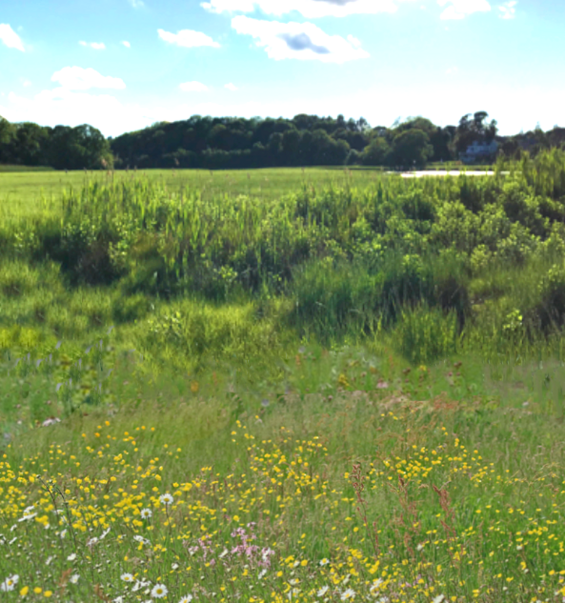
This wildflower meadow reduces stormwater impacts to the salt marsh behind it.
- Stop mowing and let your lawn grow out. The area will undergo a natural succession—from lawn grasses to a greater variety of wild grasses and wildflowers, eventually transitioning to woody shrubs and trees. This process can be enhanced by seeding with a wildflower mix or by planting a few shrubs for birds to perch on and distribute seeds. Be sure to keep a check on invasive species, such as bittersweet and honeysuckle, which have the potential to turn your meadow into a thicket of undesirable species. For more information about removing invasive species, see Stormsmart Properties Fact Sheet 3: Planting Vegetation to Reduce Erosion and Storm Damage.
- Plant perennials, shrubs, trees, and clump-forming grasses instead of lawn. You can design aesthetically pleasing planting beds or vegetated buffers (areas of natural plantings that treat stormwater runoff—see Stormwater Solutions for Homeowners Fact Sheet: Vegetated Buffers for details). Single trees within lawn areas can also be very attractive, while helping to significantly reduce stormwater runoff (since trees absorb large quantities of rainwater). As an added benefit, a tree canopy can break the impact of rainfall on soils and reduce potential erosion. See CZM’s Coastal Landscaping website for information on plant species that work well in coastal areas (many work well inland too).
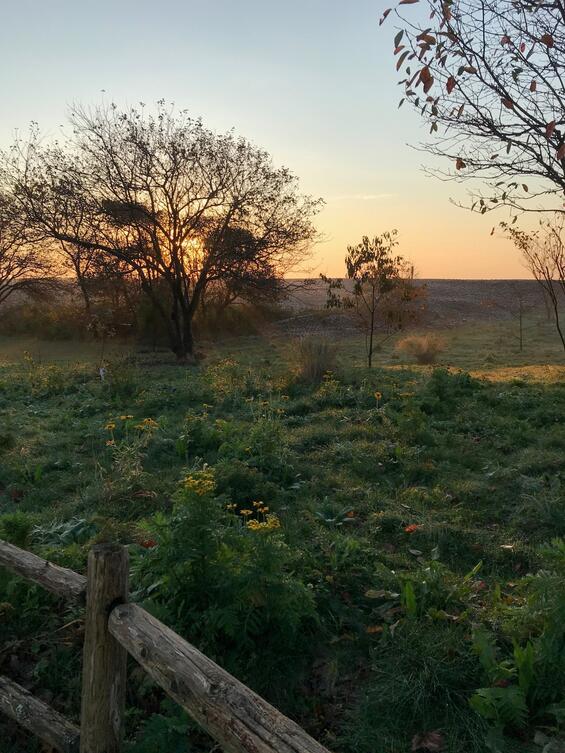
This area next to a cobble dune and beach was sown with wildflower seeds and planted with perennials, grasses, groundcovers, and a few trees to create a wildlife meadow.
- Replace lawn with other plant-based stormwater solutions. For example, rain gardens (wide depressions in the ground containing plants and porous soils) can be used to collect, filter, and treat stormwater (see Stormwater Solutions for Homeowners Fact Sheet: Rain Gardens). Similarly, vegetated swales (open, channel-like depressions in the ground) are great for slowing, treating, and conveying stormwater (see Stormwater Solutions for Homeowners Fact Sheet: Vegetated Swales).
- When replacing lawn, limit areas with exposed soils to help prevent sediments from being carried by rain and snowmelt to local water resources. Disturbed sites are also vulnerable to quick-moving channelized flows, which can inadvertently increase flooding and erosion issues on adjacent properties or roadways. Consider installing a temporary erosion-control blanket made of natural fibers on disturbed areas to stabilize the soil until plants become established (vegetation can be planted through the blanket) (see StormSmart Properties Fact Sheet 5: Bioengineering - Natural Fiber Blankets on Coastal Banks). Other erosion and sediment controls, such as filter socks or silt fences, can be used to capture sediments and prevent muddy water from running offsite (for details on these and other options, see Stormwater Solutions for Homeowners Fact Sheet: Preventing Erosion). Once natural plantings mature, the dense growth of plants will provide cover that slows water runoff, stabilizes soils, and filters and captures sediments to reduce stormwater impacts from your property.
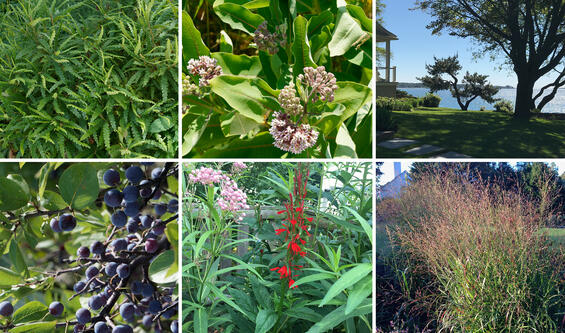
Sweet Fern (top left), Milkweed (top middle), Pitch Pine (top right), Beach Plum (bottom left), Swamp Milkweed and Cardinal Flower (bottom middle), Switchgrass (bottom right), and other perennials, grasses, shrubs, and trees are good alternatives to lawn grass, offering unique textures, features, forms, and fruits.
“Green” Lawn Techniques
For the remaining lawn areas in your yard, follow these guidelines:
- Avoid mowing the lawn right up to the edge of a waterbody or coastal resource area, such as a salt marsh or coastal bank. Instead, allow a buffer of natural vegetation to grow to help filter and slow runoff, provide wildlife habitat, and prevent erosion.
- Consider restricting the use of mowed lawns to areas needed for pathways and recreation.
- Since taller grass has a deeper and more extensive root system that is better able to withstand heat and drought, avoid cutting grass too short (generally no shorter than 2 inches). Also, mow frequently so that no more than 1/3 of the grass blade is removed at a time (to reduce plant stress) and leave the clippings on the lawn to provide a natural source of nutrients.
- Dethatch the lawn and aerate compacted soils to allow more water to infiltrate into the ground. This practice will also allow lawn roots to extend deeper into the ground and more easily absorb water.
- For existing “bluegrass” lawns, add seed from a mix of grasses, including fescues (which are more drought-tolerant and hardy than bluegrass), or replace the bluegrass altogether. A mix of species is more resistant to pests and disease and more adaptable to varying site conditions, such as shade or sun. See the University of Massachusetts Amherst’s Selection of Grasses web page for details.
- Top-dress lawns with a thin layer of compost to help build soil structure, retain moisture, provide nutrients, and improve grass growth. To top-dress without smothering a lawn, rake a half-inch layer of compost across the entire lawn, allowing the tips of the grass blades to extend through. For best results, apply the top-dressing during the active growing season and aerate the lawn first to help the compost soak into the soil. You can also use this opportunity to apply new grass seed to the lawn since the added nutrients from the compost will help the grass germinate and take root.
Water Conservation
Excess water use increases runoff and erosion, so follow these water-conservation guidelines to reduce stormwater impacts from your property:
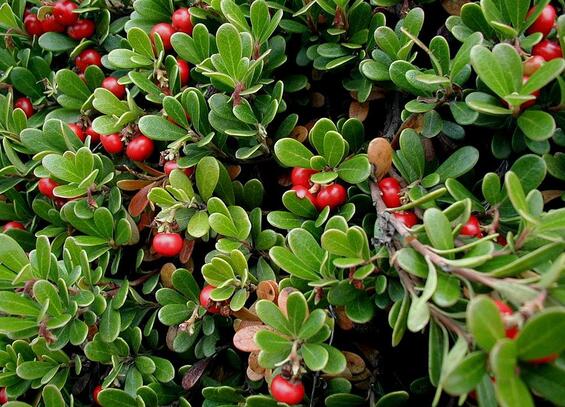
To conserve water, plant drought-tolerant native plants, like Bearberry with its evergreen leaves and bell-shaped white flowers that transition to bright red berries. (Photo credit: Sten Porse - license #CC BY-SA 3.0)
- Plant drought-tolerant native species that do not require supplemental water when established. Choose plants appropriate for site conditions, such as salt-tolerant, hardy coastal species (see CZM’s Coastal Landscaping website for specific plant choices). Group plants according to their water requirements to protect them from under- or over-watering.
- Prevent overwatering of plants and soils, which can cause numerous problems, such as plant disease, die-off of beneficial microorganisms, and leaching of nutrients through the soils. By watering less, you also encourage plants to grow deeper roots and become more conditioned to drought. Signs that plants are overwatered include limp and yellowing plant leaves or saturated and soggy soils. For best results, water as indicated on plant labels, and then wait until the top few inches of soil are dry before watering again.
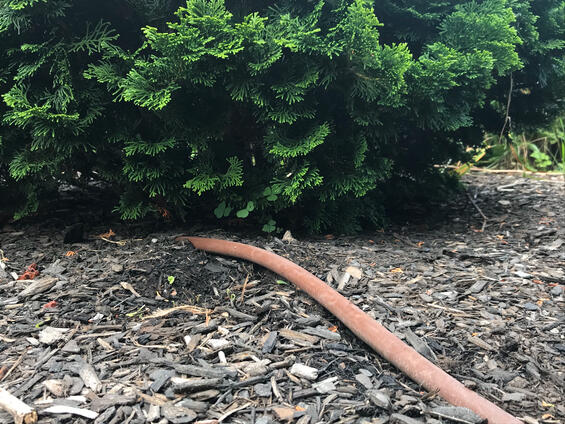
Drip tubing can effectively direct water to plant roots, reducing loss to evaporation and runoff.
- Allow lawns to go dormant when rainfall levels are low. Though the lawn may appear dead, this dormant state preserves vital parts of grass during heat and low moisture levels. The grass then revives when next saturated with water. If you do water your lawn, use an irrigation system that provides less frequent but deep watering early in the morning before evaporation rates increase.
- When other watering is necessary, water strategically. While native plants typically do not require watering once they become established, newly planted vegetation needs careful watering until the limited root system can effectively find and absorb water from the surrounding soils, particularly when planted in the hot, dry summer months. When watering larger perennials, shrubs, and trees, place an open hose (with a slow flow), a soaker hose, or drip tubing at the base of each plant, which will allow water to slowly seep into soils without creating runoff or wasting water. Temporary irrigation systems, such as portable sprinkler heads, are good for providing aerial spray to large areas of plugs and seeds. An irrigation timer can also be used to water at desired times (often early morning when less water is lost to the heat of the day). You can water less each year, with only minimal water needed in the third year after planting (if at all)—except during long periods of drought, when plants will require watering.
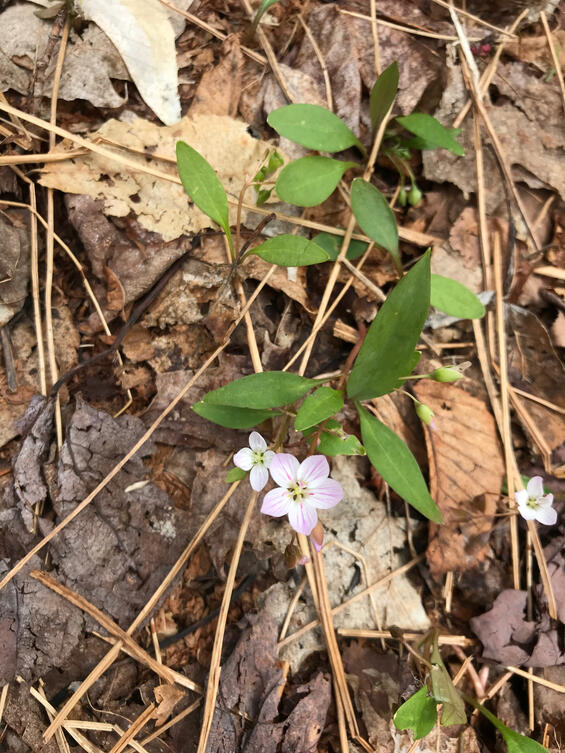
Instead of using mulch, “leave” leaf litter in place for the many natural benefits it provides.
- Keep leaf litter in place to help absorb rainwater, insulate the ground, and aerate the soil through the addition of the decaying organic matter. Leaf litter also provides a natural form of nutrients as organisms break down the organic matter and recycle carbon, nitrogen, and phosphorus back into the soil. If leaving the leaf litter is not an option, cover plant beds with a layer of mulch that is 2-3 inches thick to help retain moisture, lower soil temperatures around plant roots, prevent erosion, and reduce weed growth. A finer mulch, such as triple shredded bark, is recommended for its ability to stay in place. Keep mulch about an inch away from stems and tree trunks to avoid rot. To learn more about “living mulch” where densely established plants offer the same benefits as standard mulch but with the added bonus of creating wildlife habitat, see the Wildlife Habitat section.
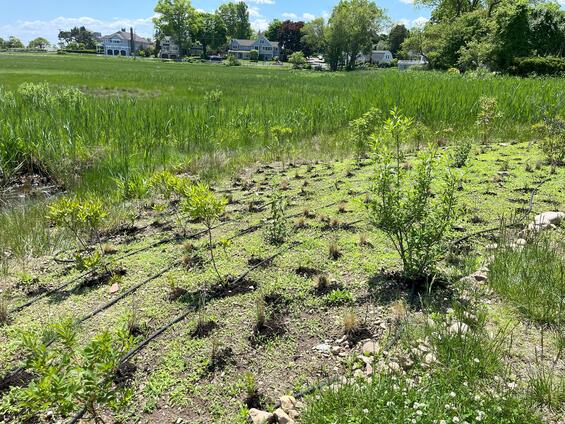
Adding compost improves both soil moisture content and drainage, helping to promote plant growth and survival. Here small amounts of compost were applied around new plants installed in a buffer area to a salt marsh.
- Apply compost to improve the structure, water retention, and nutrient content of soils, helping to boost the survival rates of plants while reducing the amount of water that would otherwise run off the site. Compost also adds organic matter that feeds the beneficial microbes and fungi (which in turn help the plants build defenses to fight off pests and diseases). For slow-draining clay and silt soils, dig or till 2-3 inches of compost into the top 6-7 inches of the garden beds to help loosen the soil, improve water drainage, and allow plant roots to spread and absorb water. Mixing some sand into the compost can also improve drainage. For nutrient-poor, quick-draining, sandy soils, mix in 3-4 inches of compost to the top 6-7 inches of soil to help retain water and nutrients. Be careful to avoid adding compost frequently since it can lead to an excessive build-up of phosphorus that can be harmful to plants, as well as impact water quality if washed off in stormwater.
Reduced Chemical Use
To help keep pollutants out of local waterbodies, reduce the use of chemical fertilizers, herbicides, and pesticides with these tips:
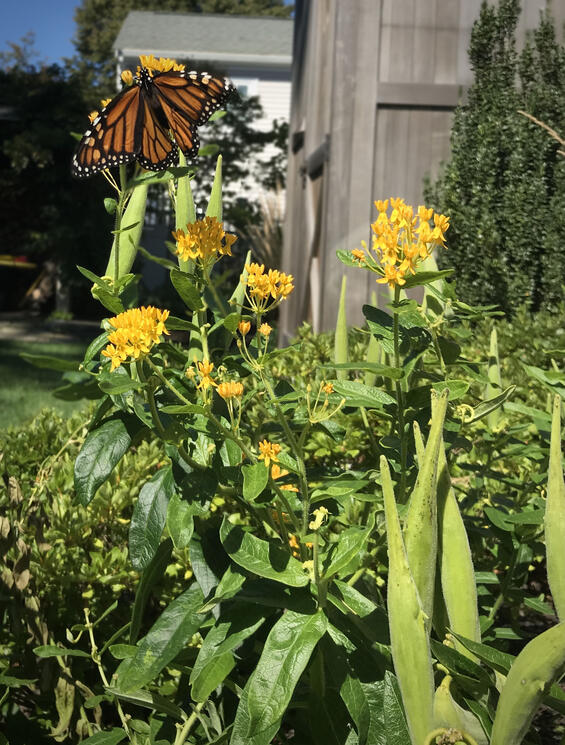
Reducing chemical use helps protect wildlife, like this monarch butterfly.
- Leave grass clippings on the lawn to naturally recycle nutrients back into the soil.
- Create your own natural fertilizer by composting. Place lawn clippings, leaves, garden trimmings, and even vegetable scraps and coffee grounds into a compost pile or bin. Turn your compost every few weeks with a pitchfork or shovel to distribute air and moisture, and spray water on the pile periodically to keep it moist. Within 3-6 months, the material will decompose into a dark and crumbly finished compost, which can then be applied to your garden and lawn. Compost not only provides nutrients for plants, it reduces runoff by helping soils to hold water. Another option is to make compost tea. Place a shovel-full of finished compost in a bucket, fill the bucket with water, let the mix sit and brew for 3-4 days, and strain. Compost tea can be sprayed onto leaves of plants, which provides nutrients (plants absorb nutrients and elements through openings on their leaves) and helps to suppress disease (beneficial microbes in the compost tea outcompete other plant pathogens). Compost tea can also be used over large areas of lawn or garden. Avoid applying compost or compost tea before a heavy rain, and store compost piles away from water resources, since even organic fertilizers can release nitrogen, phosphorus, and other nutrients that contribute to water pollution.
- Before adding commercial fertilizer, have your soil tested by the University of Massachusetts Amherst Soil and Plant Tissue Testing Laboratory. If this test determines that additional nutrients are necessary (and you don’t have compost available), use a slow-release fertilizer that provides a more controlled release of nitrogen, reducing the potential for nutrients to run off after a heavy rain or leach into groundwater. Note: To protect water quality, it is illegal in Massachusetts to use a phosphorus-containing fertilizer on lawn or non-agricultural turf unless a soil test indicates additional phosphorus is needed, and then only during the first growing season. If you do not meet these requirements, check the fertilizer bag for the percentage of nitrogen (N), phosphorus (P), and potassium (K), and use only fertilizers with “0” phosphorus.
- Rather than using commercial pesticides, provide wildlife habitat to attract birds and bats that will eat insects (see the Wildlife Habitat section and MassWildlife’s Bat Houses page for details). The National Wildlife Federation has more extensive information on their Garden for Wildlife web page. Using the methods described above to enrich soils and create healthy conditions for plants will also reduce pests and the need for pesticides.
- See the Greenscapes website for additional recommendations on composting, pesticide alternatives, and more.
Wildlife Habitat
As a side benefit, these “green” lawn and garden practices can help create backyard habitat for bees and butterflies, birds, and other wildlife (and provide you more opportunity to observe these visitors):
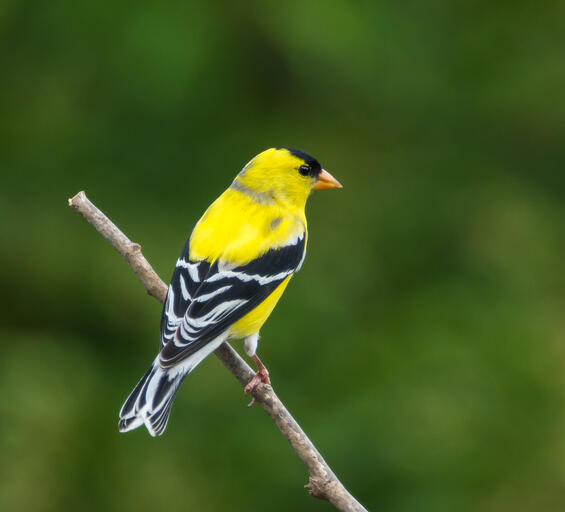
Photo credit: Mass.gov images; Shutterstock
- Grow a “living mulch” of sprawling groundcovers, low-growing plants, and thickly planted perennials between larger plants—creating a natural and connected plant community for wildlife. This natural ecological system also provides nitrogen fixing, shade, and a wind break for the plants and helps retain soil moisture, suppress weeds (through competition), and limit erosion on your property.
- Plant a shrub and tree layer to complement the living mulch and provide berries/nuts for food, a canopy for shelter, tall perches for hawks and owls, and other wildlife benefits. For the best wildlife habitat, use native trees and shrubs, including Red Maple (Acer rubrum), Black Cherry (Prunus serotina), White Oak (Quercus alba), Chokeberry (Aronia arbutifolia), and Highbush Blueberry (Vaccinium corymbosum).
- To further enhance habitat, select plants that specifically offer food and shelter. For example, native pollinator plants—such as Swamp Milkweed (Asclepias incarnata), Joe Pye Weed (Eutrochium purpureum), and Wild Bergamot (Monarda fistulosa)—are an important food source for bees, butterflies, and hummingbirds. Bearberry (Arctostaphylos uva-ursi), Pennsylvania Sedge (Carex pensylvanica), Wild Strawberry (Fragaria virginiana), and other groundcovers and low-growing plants serve as shelter. For coastal sites, salt-tolerant plants such as Beach Plum (Prunus maritima), Northern Bayberry (Myrica pensylvanica), and Eastern Red Cedar (Juniperus virginiana) can withstand the harsh conditions and serve as habitat along the shore. See the CZM Coastal Landscaping website for more on plants for coastal areas, and for additional native pollinator plants, see Mass Audubon’s Plant a Native Pollinator Garden web page or the Massachusetts Department of Agricultural Resources Creating Pollinator-Friendly Gardens with Native Plants (PDF, 770 KB).
- Leave leaf litter on the ground to provide critical overwintering habitat for eggs, larvae, pupae, and adult stages of bees, moths, butterflies, and other beneficial insects. Birds also rely on these insects to feed their nestlings (over 90 percent of terrestrial birds rear their young on insects—in particular, caterpillars).
- Avoid deadheading or cutting back perennials in the fall to provide winter shelter and hiding spaces for insects, birds, and small mammals. Perennials that are allowed to set seed and remain through the winter also serve as a food source for birds and a seed source for your garden in the spring, and the downy seed heads on plants such as milkweed and thistle are often used by birds as nesting material.
- Build a brush pile of discarded stems and branches. Songbirds, small mammals, reptiles, and amphibians use brush piles for nesting and protection from predators and harsh weather conditions.
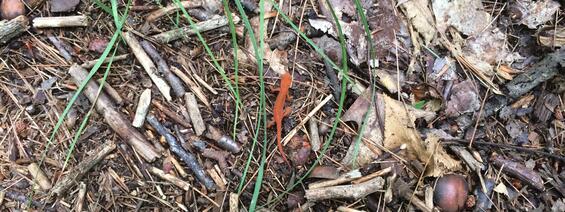
Rain Barrels
Significant quantities of rainwater and snowmelt run into roof downspouts. You can decrease stormwater runoff by directing downspouts into rain barrels to capture this water, which can be stored and reused for watering plants, washing cars, filling pools, or similar uses (other than drinking water). Follow these steps to get started:
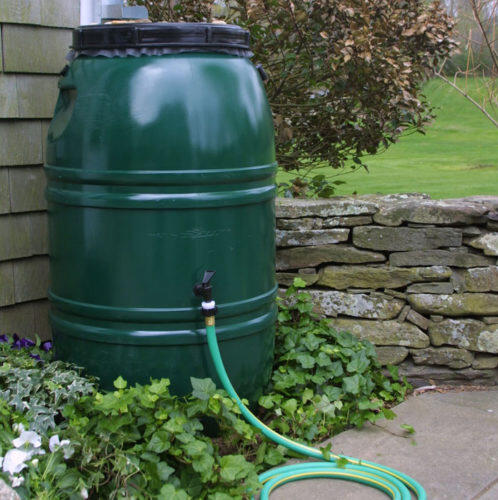
A rain barrel catches roof runoff and provides a reusable source of water for the lawn and garden. (Photo credit: North and South Rivers Watershed Association)
- Build or purchase a rain barrel. Many municipalities offer rain barrel programs—contact your local water or public works department to find out about possible programs and sales. To contact local vendors directly, see options within the Rain Barrel Guide from the Massachusetts Department of Environmental Protection.
- Choose a rain barrel location that is next to a downspout and higher than the garden, flower bed, or lawn that will be watered from the barrel (since rain barrels rely on gravity flow, unless a pump is installed). If you are going to use a raised platform to elevate the barrel, make sure it can support the weight of the filled barrel (over 400 pounds).
- Cut the downspout at a height where it can be directed into the barrel. Downspout elbow sections and flexible extensions can be purchased to help get the right fit. Alternatively, a downspout diverter can be installed to funnel water into the rain barrel without removing a section of the downspout.
- Attach a hose to the rain barrel’s spigot. Since rain barrels have low pressure flow (every 2.3 feet in elevation provides 1 pound of pressure), a hose that provides drip irrigation is most effective for watering plants.
- Use the collected rainwater on non-edible plants since roof runoff may contain low levels of bacteria due to the presence of birds and other animals.
- Attach an overflow hose to the rain barrel to direct any excess water away from the foundation and to another rain barrel, dry well, rain garden, or other infiltration method.
- Install a screen and cover on the top of the rain barrel as a safety measure, as well as to keep out mosquitoes, leaves, and debris.
- Use the water in rain barrels on a regular basis to allow additional roof runoff to be stored.
- Keep roof gutters clean to help prevent sediment and other debris from getting into the rain barrel.
- Unless the rain barrel can withstand freezing temperatures, clean it out at and store it indoors before winter. (Be sure to replace any portion of the downspout that was removed when it was installed.)
Additional Information
- For related fact sheets, see the CZM Stormwater Solutions for Homeowners fact sheet website.
- The CZM Coastal Landscaping website has details on landscaping coastal areas with salt-tolerant vegetation to reduce storm damage and erosion.
- CZM’s StormSmart Properties Fact Sheet 3: Planting Vegetation to Reduce Erosion and Storm Damage gives specific information for homeowners on appropriate plants for erosion control in coastal areas, along with guidance on removing invasive species.
- CZM’s StormSmart Properties Fact Sheet 5: Bioengineering - Natural Fiber Blankets on Coastal Banks provides details for homeowners on bioengineering projects that combine the use of erosion-control plants with mats made of natural fibers that help reduce erosion of exposed sediments from wind, waves, and overland runoff.
- The Massachusetts Department of Agricultural Resources (DAR) Choosing Pollinator-Friendly Native Plants in Home Gardening or Landscaping page includes a curated list of downloadable resources and events, with resources on pollinator gardens, landscaping plans, and where to purchase native plant species and seeds.
- Grow Native Massachusetts Flora and Fauna page offers resources ranging from native plant databases, invasive plant lists, and options for researching various types of wildlife, from birds to butterflies.
- The Greenscapes website provides information on “green” lawn and gardening practices and includes a downloadable Greenscapes Guide that details how to use attractive, nature-friendly landscaping practices to reduce pollution, conserve water, support wildlife, and protect against climate change.
- University of Massachusetts (UMass) Amherst Extension Program’s Best Management Practices (BMPs) for Lawn and Landscape Turf offers options for reducing impacts when managing irrigation and nutrient levels and controlling weeds, insects, and disease.
- UMass Amherst Extension Program’s Selection of Grasses web page provides information on choosing turf grasses that are best adapted to your environmental conditions, intended use, and desired maintenance level.
- UMass Amherst’s Soil and Plant Tissue Testing Laboratory offers soil testing services for homeowners and others to determine soil fertility and nutrient management options.
- DAR’s Fertilizer Facts includes information on minimizing impacts to water supplies when using fertilizer.
- Northeast Organic Farming Association Organic Land Care Program’s Introduction to Organic Lawns and Yards (PDF, 2 MB) outlines landscaping principles for homeowners that protect the environment and human health.
- U.S. Environmental Protection Agency’s (EPA) Soak Up the Rain website includes outreach tools and how-to guides on topics such as Rain Barrels, Disconnecting Downspouts, Trees, Permeable Pavement, and Green Roofs.
- EPA’s WaterSense Landscaping Tips web page includes a Water-Smart Landscapes Guide (PDF, 2 MB) with detailed guidance on selecting plants, maintaining soils, and managing lawns for a healthy landscape.
- GreenScaping: The Easy Way to a Greener, Healthier Yard by the EPA provides information on using pesticides wisely and conserving water.
- The National Wildlife Federation’s Garden for Wildlife web page gives information on food sources, water use, and plant cover to provide habitat for wildlife.